
A First Course on Wireless Communication
 Welcome to the exciting field of wireless communication. If you
are looking for a first introduction into this area, this page may
help you with suggestions. We propose that you
follow this procedure:
Welcome to the exciting field of wireless communication. If you
are looking for a first introduction into this area, this page may
help you with suggestions. We propose that you
follow this procedure:
- Step 1: Read this page entirely without clicking on any hypertext link.
- Step 2: Answer the questions at the end of each section by
checking the suggested links.
| Note: Some of the linked pages may
contain terms or concepts that you do not yet fully comprehend. For time being,
do not click on further links, but try to focus on
answers to the question you are looking for.
Type up or cut and paste answers to the questions and feel free to email
the set of answers to the disc editor.
|
- Step 3: Check the links suggested on this page again, and try to understand
every page entirely. Feel free to clink on any link of your interest. Use the
navigational menu of your browser to return to this page.
Success!

The importance of wireless communication
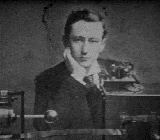 Wireless communication started with the invention of the
wireless telegraph. This innovation allowed communication with ships
on the oceans. Wireless telegraphy was also used for
communication across the Atlantic and the Pacific,
particularly after the events of World War I showed the vulnerability of
undersea telegraph cables.
Wireless communication started with the invention of the
wireless telegraph. This innovation allowed communication with ships
on the oceans. Wireless telegraphy was also used for
communication across the Atlantic and the Pacific,
particularly after the events of World War I showed the vulnerability of
undersea telegraph cables.
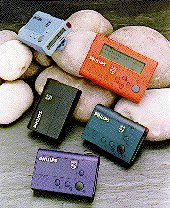
Wireless voice communication became technically feasible around 1915.
Around 1920, broadcasters began to transmit their programs "over the
air".
World War II gave a strong impetus to radio communication technology,
but for a long time speech communication by radio
was only available to the military and to closed user groups, such as
law enforcement officers.
Advances in (micro) electronics accelerated further development of mobile communication systems.
Analog automatic public telephony appeared in the seventies. A switch-over to
digital systems is currently underway.
The systems of today can also provide other services than just telephony,
for instance short message services, data communications and facsimile.
Nowadays wireless radio communication plays an increasing role in
providing flexible and convenient access to
the fixed communication infrastructure (the "information highway").
Most technical limitations
are now well understood, and many issues can well be handled by
state of the art technology.
Modern systems provide
transmit rates and Quality of Service that make wireless
multi-media services possible.
- Who were the pioneers of wireless telegraphy?

- How has the role of wireless changed over the years?

- What are the main issues in wireless communication?

- How will wireless systems evolve?

The principles of cellular telephony
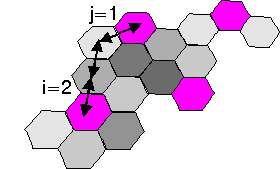
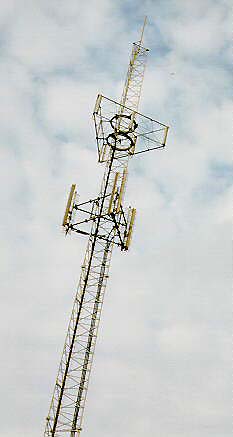 In 1974, the FCC allocated 40 MHz of radio spectrum to public
radio telephony. In the late seventies, it became clear that the existing
radio telephone system would not be able to accommodate the increasing
demand from subscribers. Research into more efficient use of the
radio spectrum led to the development of cellular frequency reuse.
The service area of an operator is divided into many small areas, each
covered by a base station. A fundamental question is under which conditions
cells may share the same frequency.
In 1974, the FCC allocated 40 MHz of radio spectrum to public
radio telephony. In the late seventies, it became clear that the existing
radio telephone system would not be able to accommodate the increasing
demand from subscribers. Research into more efficient use of the
radio spectrum led to the development of cellular frequency reuse.
The service area of an operator is divided into many small areas, each
covered by a base station. A fundamental question is under which conditions
cells may share the same frequency.
- Why do people call (AMPS) wireless phones "cellular phones"?

- What are the basic principles of cellular frequency reuse?

- How big is a cell?

- What happens if a cellular phone moves out of the coverage area of its base
station?

- Is sprectum scarcity still an issue?

- What is the difference between cellular and cordless phones?

Cellular Telephone Systems
The U.S. analog AMPS system attracted many subscribers. One of the main success factors was that the entire U.S. uses a single common standard for analog cellular telephony. This is in contrast to
the situation in Europe, where many non-compatible analog systems and standards were in use.
The European countries developed an innovative new digital system, called GSM, which
is on its way to becoming a global success. In the U.S., two standards compete,
with significantly different transmission standards.
- Is there a spectrum-conservation reason to switch to digital systems?

- What are the important factors that contributed to the success of GSM?

- GSM is a TDMA system. What does that mean?

- Which two systems compete for the US digital cellular standard? What is
the main technical difference between these two systems?

Other Wireless Systems and Services
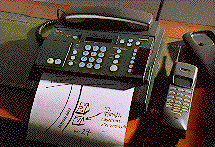 Several Research & Development initiatives aim at standardizing
a universal personal communications system, capable
of providing a multitude services, working reliably in any propagation environment.
Meanwhile, we have seen the introduction of several different
new network concepts in the last decade.
Mostly, these systems provide only a limited set of functionality. Examples are systems for
cordless telephony, paging, digital broadcasting and wireless local area networking.
Several Research & Development initiatives aim at standardizing
a universal personal communications system, capable
of providing a multitude services, working reliably in any propagation environment.
Meanwhile, we have seen the introduction of several different
new network concepts in the last decade.
Mostly, these systems provide only a limited set of functionality. Examples are systems for
cordless telephony, paging, digital broadcasting and wireless local area networking.
- Data over cellular
- Why are telephone networks less suitable for data transmission?

- Which special data transmission services can be provided through GSM?

- What is the name of the standard allowing data transmission in the U.S.
AMPS network?

- Cordless
- Why is the DECT system particularly suitable for office data communication?

- Wireless LANs
- Which frequency bands are of interest for license-free operation of wireless
LANs?

- Broadcast Systems
- Why do only few broadcasters use digital systems?

- Can analog FM broadcast radio provide digital data services?

- What other services can Digital Audio Broadcasting provide besides disseminating
radio programmes?

- What are the three transmission media envisaged for Digital Television?

Wireless Propagation
 One of the main challenges in wireless communication is
to achieve reliable transmission over
the "hostile" mobile radio channel. The mobile propagation
channel is notoriously poor. The main problems are
rapid time variations of the channel and frequency selectivity.
One of the main challenges in wireless communication is
to achieve reliable transmission over
the "hostile" mobile radio channel. The mobile propagation
channel is notoriously poor. The main problems are
rapid time variations of the channel and frequency selectivity.
- Which three mechanisms affect wireless propagation?

- How rapidly do radio signals get weaker if one moves the receiver away from
from the transmitter?

- If I loose my radio signal while waiting for a traffic light, why do I receive
the signal clearly if I move only half a meter.

- If a mobile antenna receives a signal over different paths, what is the
effect of the angle of arrival of such a path?

- What is the effect of a delay spread on a digital signal?

- To what extent does the indoor channel differ from macro-cellular propagation?

Transmission Methods
Good and cost effective
solutions to combat the effects of multipath fading depend on the environment and system requirements.

A good modulation method is
spectrum efficient, robust against noise, interference,
fading and multipath delay spread,
and
allows a simple and power-efficient implementation of the portable terminal.
- What factors determine the signal outage probability?

- How can diversity improve the BER?

- What modulation method is used in GSM?

- What kind of systems use spread-spectrum transmission?

- How does a Direct Sequence transmitter work?

- How can slow frequency hopping improve the performance or capacity of a
cellular telephone network?

Multiple Access
As the radio spectrum has limited bandwidth, radio communication resources
must be shared efficiently
amoung many users. The basic unit of spectrum resources is
"Hz . sec . square kilometer", i.e., it involves bandwidth, time
and area factors.
To a cellular operator, employing a
more spectrum-efficient system means that he can accommodate
more subscribers in the same bandwidth.

For data and multi-media traffic, resource management is more complicated
than for telephony. Because of the bursty nature of the traffic, the system must rapidly adapt to the changing needs of the users.
- What are the basic principles of assinging spectrum resources to a fixed
group of users?

- What is the main difference between ALOHA and CSMA?

- What can happen if the ALOHA protocol is unstable?

- What is the hidden terminal problem and how can it be resolved?





 www.WirelessCommunication.NL
www.WirelessCommunication.NL www.WirelessCommunication.NL
www.WirelessCommunication.NL

 Wireless communication started with the invention of the
wireless telegraph. This innovation allowed communication with ships
on the oceans. Wireless telegraphy was also used for
communication across the Atlantic and the Pacific,
particularly after the events of World War I showed the vulnerability of
undersea telegraph cables.
Wireless communication started with the invention of the
wireless telegraph. This innovation allowed communication with ships
on the oceans. Wireless telegraphy was also used for
communication across the Atlantic and the Pacific,
particularly after the events of World War I showed the vulnerability of
undersea telegraph cables.


 In 1974, the FCC allocated 40 MHz of radio spectrum to public
radio telephony. In the late seventies, it became clear that the existing
radio telephone system would not be able to accommodate the increasing
demand from subscribers. Research into more efficient use of the
radio spectrum led to the development of cellular frequency reuse.
The service area of an operator is divided into many small areas, each
covered by a base station. A fundamental question is under which conditions
cells may share the same frequency.
In 1974, the FCC allocated 40 MHz of radio spectrum to public
radio telephony. In the late seventies, it became clear that the existing
radio telephone system would not be able to accommodate the increasing
demand from subscribers. Research into more efficient use of the
radio spectrum led to the development of cellular frequency reuse.
The service area of an operator is divided into many small areas, each
covered by a base station. A fundamental question is under which conditions
cells may share the same frequency.
 Several Research & Development initiatives aim at standardizing
a universal personal communications system, capable
of providing a multitude services, working reliably in any propagation environment.
Meanwhile, we have seen the introduction of several different
new network concepts in the last decade.
Mostly, these systems provide only a limited set of functionality. Examples are systems for
cordless telephony, paging, digital broadcasting and wireless local area networking.
Several Research & Development initiatives aim at standardizing
a universal personal communications system, capable
of providing a multitude services, working reliably in any propagation environment.
Meanwhile, we have seen the introduction of several different
new network concepts in the last decade.
Mostly, these systems provide only a limited set of functionality. Examples are systems for
cordless telephony, paging, digital broadcasting and wireless local area networking.
 One of the main challenges in wireless communication is
to achieve reliable transmission over
the "hostile" mobile radio channel. The mobile propagation
channel is notoriously poor. The main problems are
rapid time variations of the channel and frequency selectivity.
One of the main challenges in wireless communication is
to achieve reliable transmission over
the "hostile" mobile radio channel. The mobile propagation
channel is notoriously poor. The main problems are
rapid time variations of the channel and frequency selectivity.

